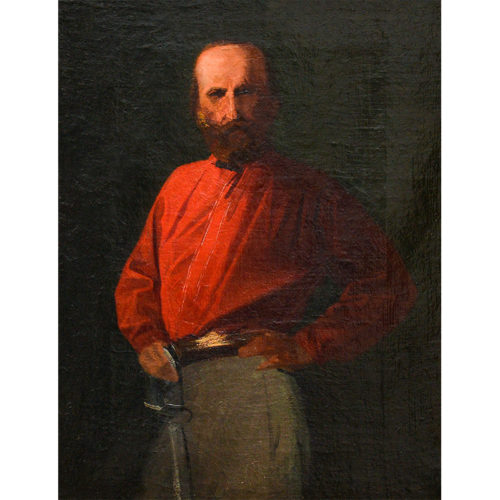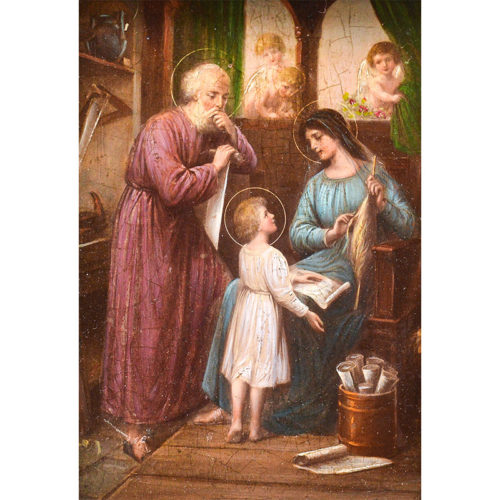"Garibaldi" - Oil on canvas by Teofilo Patini (1840-1906)
PATINI TEOFILO. Born in Castel di Sangro (L'Aquila) on May 5, 1840, died in Naples on November 16, 1906. He moved to Naples at a very young age, after graduating in Fine Arts; he enrolled at the Institute of Fine Arts, where Filippo Palizzi was teaching at the time. During the courses he easily won several prizes and finally obtained a pensioner to go to Rome, where he studied deeply the ancient masters and in particular those of the seventeenth century. He also was strongly influenced from Dutch paintings, but, above all, it was the Meissonnier who conquered him. He first dealt, for a short period of time, with the historical picture; then, with his sensitive and scornful soul, as an attentive observer of the events of human life, he gave himself to social painting, expressed with a strong and meticulous verism. His masterpiece is L'erede, which was exhibited in Milan in 1881 and is now found in the Gallery of Modern Art in Rome with Spade and Milk, exhibited in Turin in 1884. Other important paintings of his are: Il Parmigianino; The sack of Rome, of the Municipality of Naples; Art and freedom; Salvator Rosa's studio, exhibited in Turin in 1880 and in Vienna; Every good boot becomes a slipper; The first riding lesson, which is owned by the baritone Titta Ruffo; Pack animals, sent to Venice in 1887; Rocky landscape, in the M.O. collection of Milan; The riding lesson, in the Borgogna Museum of Vercelli; The country doctor; Belly and heart; The company of death: After defeat; The good ones; The notables of my country; The eagle; The caralluccio; Return to the sheepfold; The chain. Patini also tried, with less success, the sacred subject, and the paintings are remembered in this regard: Gloria del Sacramento; The temptations of Saint Anthony; Christ in the garden; The Redeemer; Christ raises the widow's son; The Annunziata; Il Purgatorio: The Crucifix; The Guardian Angel; Sant'Antonio di Padova; San Carlo Borromeo. There are also the sketches for the decorations of the Aula Magna of the University of Naples (work that, for the artist's death, remained unfinished), and the frescoes in the hall of the City Council of the same city. His students include M. Dragonetti Cappelli, E. Rubei, Vittor Scarselli.
-
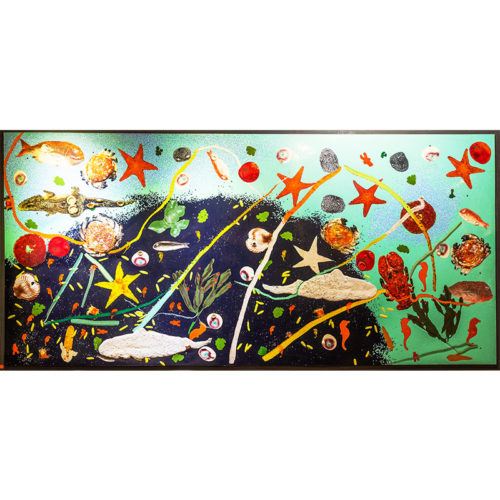 The most important work of Omar Aprile Ronda (Portula, 11 September 1947 - Biella, 7 December 2017), was an Italian artist, painter, sculptor, art collector and publisher. The work is published on the cover of the catalog "Genetic Fusions - Genetic Fusions" of 1991 of which a quote is reported below: "Genetic Fusions" are fascinating for their relation with the infinitely small, within which thousands of events take place and where order seems to be the highest law we are not allowed to know yet, but that the artist makes us perceive through imagination and poetry" The work is dated and signed on the back by the author who guarantees its authenticity. Period: 1990 Measurements: H 135 x L 281 cm
The most important work of Omar Aprile Ronda (Portula, 11 September 1947 - Biella, 7 December 2017), was an Italian artist, painter, sculptor, art collector and publisher. The work is published on the cover of the catalog "Genetic Fusions - Genetic Fusions" of 1991 of which a quote is reported below: "Genetic Fusions" are fascinating for their relation with the infinitely small, within which thousands of events take place and where order seems to be the highest law we are not allowed to know yet, but that the artist makes us perceive through imagination and poetry" The work is dated and signed on the back by the author who guarantees its authenticity. Period: 1990 Measurements: H 135 x L 281 cm -
Out of stock
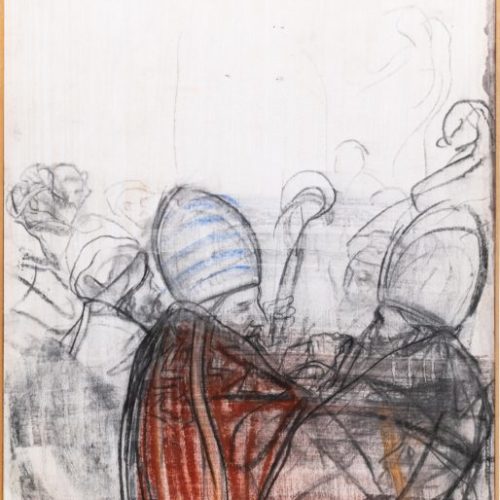 "Glory of St. Benedict" mixed media on paper by Pietro Annigoni (1910-1988), on the reverse side cartouche of the IInd Biennale of Sacred Art of Pescara. Measurements: In frame H 99.5 x W 78.5 x D 10 / Paper H 80 x W 60 cm
"Glory of St. Benedict" mixed media on paper by Pietro Annigoni (1910-1988), on the reverse side cartouche of the IInd Biennale of Sacred Art of Pescara. Measurements: In frame H 99.5 x W 78.5 x D 10 / Paper H 80 x W 60 cm -
Out of stock
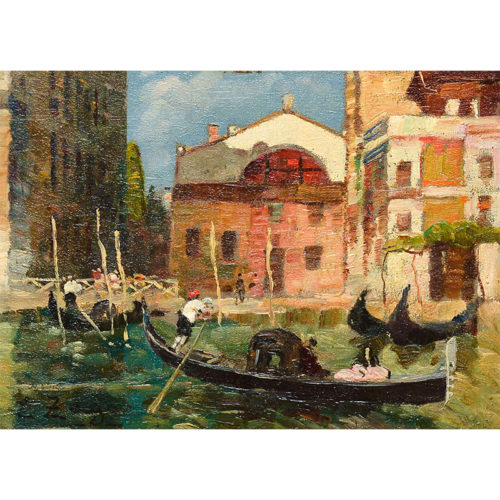 Gondolas in Venice, Erma Zago (1880-1942), oil on tablet, signed on the lower left, with a dedication on the back. Dating from the early 1900s.Period: Early 1900s Measurements: In frame H 39 x W 46.5 / Canvas on wood H 19 x W 26.5 cm
Gondolas in Venice, Erma Zago (1880-1942), oil on tablet, signed on the lower left, with a dedication on the back. Dating from the early 1900s.Period: Early 1900s Measurements: In frame H 39 x W 46.5 / Canvas on wood H 19 x W 26.5 cm -
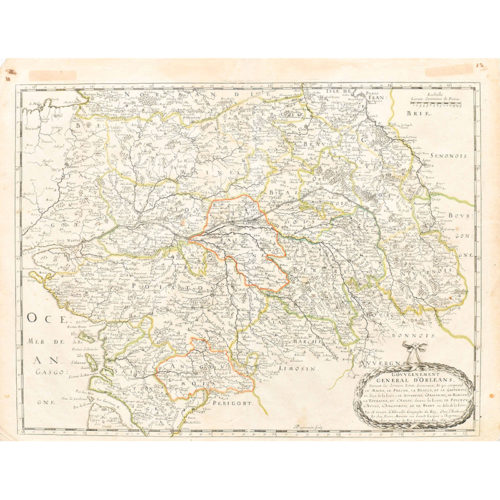 Beautiful example of the engraved map of Nicolas Sanson d'Abbeville from 1650. Nicolas Sanson (1600-1667), sometimes called Nicolas Sanson d'Abbeville or Sanson d'Abbeville, was the most important French cartographer of the 17th century. Tooley called Sanson "the founder of the French school of cartography". He started making cards at the end of 1620, and in 1630 he worked with Melchior Tavernier. Subsequently, Sanson worked in concert with the publisher Pierre Mariette, with whom he published his great atlas: general maps of all parts of the world (1658). After Sanson's death in 1667, his son Guillaume ran the business in collaboration with Alexis Hubert Jaillot. Guillaume has established himself as a full-fledged very important French cartographer.Period: 1650 Measurements: In frame H 65 X L 79 / Paper H 44 X L 56 cm
Beautiful example of the engraved map of Nicolas Sanson d'Abbeville from 1650. Nicolas Sanson (1600-1667), sometimes called Nicolas Sanson d'Abbeville or Sanson d'Abbeville, was the most important French cartographer of the 17th century. Tooley called Sanson "the founder of the French school of cartography". He started making cards at the end of 1620, and in 1630 he worked with Melchior Tavernier. Subsequently, Sanson worked in concert with the publisher Pierre Mariette, with whom he published his great atlas: general maps of all parts of the world (1658). After Sanson's death in 1667, his son Guillaume ran the business in collaboration with Alexis Hubert Jaillot. Guillaume has established himself as a full-fledged very important French cartographer.Period: 1650 Measurements: In frame H 65 X L 79 / Paper H 44 X L 56 cm -
Out of stock
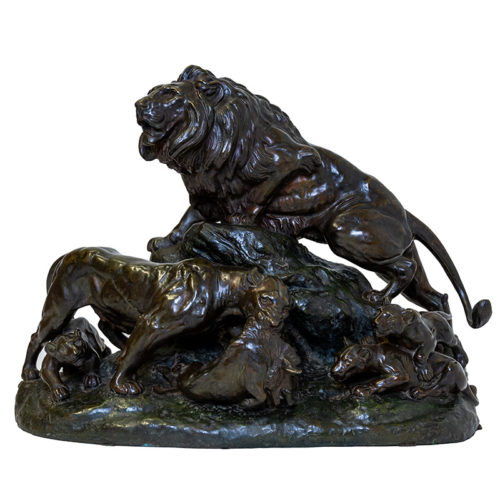 Beautiful bronze animal sculpture depicting a group of lions by Clovis Edmond Masson (1838, Paris - 1913). Signed by the author on the basement.Period: Second half of the 19th century Measurements: H 60 x L 46 x P 30 cm
Beautiful bronze animal sculpture depicting a group of lions by Clovis Edmond Masson (1838, Paris - 1913). Signed by the author on the basement.Period: Second half of the 19th century Measurements: H 60 x L 46 x P 30 cm -
Out of stock
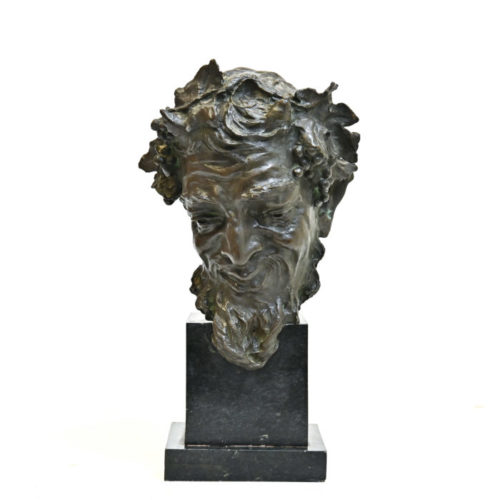 "Head of Satyr" - Bronze sculpture by Vincenzo Gemito (Naples, 16 July 1852 - Naples, 1 March 1929), Italian sculptor, designer and goldsmith. In Naples he was known as "’ o crazy sculptor " because he was tormented and marked by profound psychic imbalances; in reality his name was Vincenzo Gemito (Naples 1852 - 1929), a goldsmith and sculptor who, due to his condition, was often forced to take long breaks from his creative activity. His life was not simple right from the start: he was abandoned to his fate by his parents after being deposited in the wheel of exposures of the Annunziata plant. In fact, his real surname was Genito - "generated" - usually associated with orphans, but due to a mistake by a scribe the N became an M. Adopted and raised in a very poor family, from an early age Gemito proved to be gifted with immense talent for the plastic arts. His watchful eye loved to dwell above all on the scenes of the Neapolitan slums and his favorite subjects were children dressed in rags, commoners and players. The Gallerie d’Italia in Naples houses one of the most important nucleus of the artist's works, coming from the collection of the lawyer Gabriele Consolazio: terracotta, bronzes and drawings produced between the 1870s and the 1920s of the following century. The young heads modeled in terracotta - such as the impressive "Scugnizzo", "Fiociniere" and "Moretto" - testify to his tendency towards naturalism. Much more sophisticated are the bronze portraits of famous people, such as that of the Spanish painter Mariano Fortuny and his contemporary Domenico Morelli. His tireless plastic research is represented in particular by the "Philosopher's head" and the later "Neapolitan girl's bust", characterized by a sensual classicism that recalls the seductions and virtuosity of ancient Hellenistic sculpture. The drawings made with different materials and procedures are no less splendid: Gemito, in fact, knew how to master pencil, charcoal, ink, watercolor, sanguine and white tempera with the same skill. The engaging self-portraits are exhibited at Palazzo Zevallos Stigliano, merciless evidence of the painful changes in his physiognomy over the years; another important series on display consists of the figures of women where it is possible to observe the style research inspired by seventeenth-century models that made Vincenzo Gemito the last follower of Neapolitan naturalism.Period: '900 Measurements: H 42 x W 23 x D 23 cm
"Head of Satyr" - Bronze sculpture by Vincenzo Gemito (Naples, 16 July 1852 - Naples, 1 March 1929), Italian sculptor, designer and goldsmith. In Naples he was known as "’ o crazy sculptor " because he was tormented and marked by profound psychic imbalances; in reality his name was Vincenzo Gemito (Naples 1852 - 1929), a goldsmith and sculptor who, due to his condition, was often forced to take long breaks from his creative activity. His life was not simple right from the start: he was abandoned to his fate by his parents after being deposited in the wheel of exposures of the Annunziata plant. In fact, his real surname was Genito - "generated" - usually associated with orphans, but due to a mistake by a scribe the N became an M. Adopted and raised in a very poor family, from an early age Gemito proved to be gifted with immense talent for the plastic arts. His watchful eye loved to dwell above all on the scenes of the Neapolitan slums and his favorite subjects were children dressed in rags, commoners and players. The Gallerie d’Italia in Naples houses one of the most important nucleus of the artist's works, coming from the collection of the lawyer Gabriele Consolazio: terracotta, bronzes and drawings produced between the 1870s and the 1920s of the following century. The young heads modeled in terracotta - such as the impressive "Scugnizzo", "Fiociniere" and "Moretto" - testify to his tendency towards naturalism. Much more sophisticated are the bronze portraits of famous people, such as that of the Spanish painter Mariano Fortuny and his contemporary Domenico Morelli. His tireless plastic research is represented in particular by the "Philosopher's head" and the later "Neapolitan girl's bust", characterized by a sensual classicism that recalls the seductions and virtuosity of ancient Hellenistic sculpture. The drawings made with different materials and procedures are no less splendid: Gemito, in fact, knew how to master pencil, charcoal, ink, watercolor, sanguine and white tempera with the same skill. The engaging self-portraits are exhibited at Palazzo Zevallos Stigliano, merciless evidence of the painful changes in his physiognomy over the years; another important series on display consists of the figures of women where it is possible to observe the style research inspired by seventeenth-century models that made Vincenzo Gemito the last follower of Neapolitan naturalism.Period: '900 Measurements: H 42 x W 23 x D 23 cm
